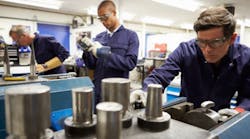U.S. manufacturing suffers from an important image problem that undermines its competitiveness, according to a new survey released on July 13 by Deloitte, along with the Manufacturing Institute.
Only 50% of Americans think manufacturing jobs are interesting and less than 30% are likely to encourage their children to pursue a career.
However Americans have not yet given up hope on the industry and in fact are overwhelmingly optimistic for its future:
- 55% believe that sector can compete globally
- 81% that future manufacturing jobs will occur in safer and cleaner environments
- 64% believe the industry is high-tech
- 76% of respondents believe the U.S. needs a more strategic approach to develop manufacturing
While the future looks bright, much needs to be done to make sure that the public, including educators and those in a position to guide talent to the industry, understand the facts, the report concludes. For example, many people feel that the industry does not offer well-paid jobs. However, workers in the sector currently earn $20,000 more including pay and benefits, compared to employees in other industry. Manufacturing holds the highest average wages ($81,289) across all private sector industries and has one of the lowest turnover rates (2.3%).
The authors of the report believe that now is the time to fix this problem.
The American public’s perception of manufacturing may be at an inflection point. The good news is manufacturing clearly matters to many Americans, with the vast majority viewing U.S. manufacturing as crucial to America’s economic prosperity, standard of living, and national security. In the mind of the average American, though, many of the current perceptions of manufacturing haven’t kept pace with advances in the industry, leaving a gap between perceptions and reality in terms of critical factors such as job stability, pay, and benefits. Furthermore, many are not eager to encourage their children to pursue a career in the industry. Nonetheless, important and influential demographic groups, such as parents as well as those familiar with the industry, consider the manufacturing industry in higher regard.
To turn perceptions around the report offers the following steps that manufacturers, either individually or collectively, can take to actively create more positive perceptions about the industry.
1. Get the good news out and dispel false impressions of the industry
This can be advocated through conversations and speeches and by conducting events like Manufacturing Day to make the U.S. public more aware of the strong and positive truths about manufacturing. “Did you know?” types of campaigns—to help disseminate real facts associated with the manufacturing industry, like it having the highest wages, longest tenure, and strongest multiplier effect among all industries—can go a long way in improving the present perception of the industry among the general public.
2. Highlight top priorities that people seek in a career
Manufacturers can underscore areas that matter most to prospective candidates. The manufacturing industry already provides careers that have good job benefits, pay, and are interesting and rewarding—key things that the American public desires. Recognizing that the war for top talent extends far beyond the manufacturing industry, companies will likely need to increase focus on what will attract and retain the best and brightest talent so they can become destinations of choice.
3. Invest in and foster high-interest programs
Programs directed toward hands-on skill development may find the most traction among the American public, as far as increasing interest in manufacturing is concerned. Manufacturers should take note that apprenticeships, internships, and certification-based training programs top the list.
4. Create more awareness of events like Manufacturing Day
Only eight percent of Americans surveyed are currently aware or familiar with it. However, over 90% of those attending Manufacturing Day events are more convinced that manufacturing provides interesting and rewarding careers, and more than 80% are likely to tell others about manufacturing. Such events, if successfully conducted, can go a long way in creating awareness, dispelling false perceptions, and providing a practical experience that demonstrates the benefits of a manufacturing career.
5. Leverage segments with higher interest and perception levels
Surveyed segments such as women, Americans with high manufacturing familiarity, and American parents are more positive about manufacturing in the sense that they have a better image and perception about the U.S. manufacturing industry. These demographic segments can be leveraged as brand ambassadors in order to improve and influence manufacturing perception within other segments.
6. Tap into the strong associations between manufacturing and economic prosperity
It’s clear that Americans surveyed believe a strong manufacturing industry is vital to the nation—its economy, people, and national priorities. Manufacturers could do more to tap into the patriotic pride of a strong industrial base.
7. Generate awareness around state-of-the-art advanced technologies critical to manufacturing
Advanced technologies like predictive analytics and advanced materials—which are deemed critical to the future of manufacturing by executives—should have top-of-mind awareness among the American public. Manufacturers can emulate their
Silicon Valley counterparts by weaving a “cool” image of their industry with that of advanced technologies and innovation. Anecdotal evidence also suggests that Gen Y and Z Americans are tech-savvy and always look forward to what technology has to offer, both in their personal and professional lives.
8. Design collaboration initiatives that bring industry, government, and academia together
Manufacturers could benefit from better enabling and tapping into a larger ecosystem that fosters innovation and creates more opportunities to attract top talent across a broader spectrum. The manufacturing industry can benefit from ecosystem players coming together for awareness-raising campaigns and initiatives. We believe there’s a need to create a collective call to action by all key stakeholders to make manufacturing a destination of choice.




